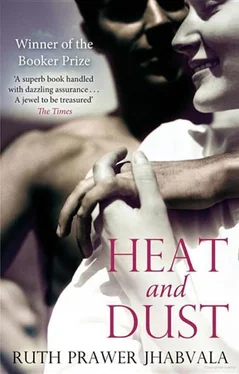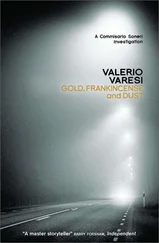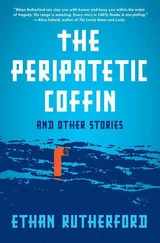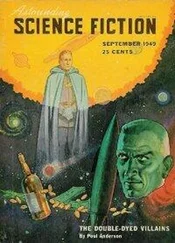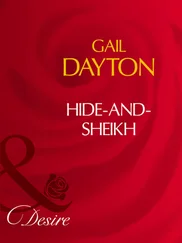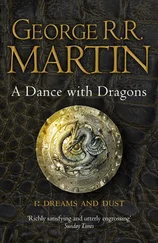24 February. Today being Sunday, Inder Lal kindly offered to take me to Khatm to show me the Nawab's palace. I felt bad about taking him away from his family on his one day off, but neither he nor they seemed to think anything of it. I wonder his wife does not get tired of being shut up in her two small rooms all day and every day, with her mother-in-law and three small children. I never see her go out anywhere except sometimes — accompanied by her mother-in-law — to buy vegetables in the bazaar.
I have not yet travelled on a bus in India that has not been packed to bursting-point, with people inside and luggage on top; and they are always so old that they shake up every bone in the human body and every screw in their own. If the buses are always the same, so is the landscape through which they travel. Once a town is left behind, there is nothing till the next one except flat land, broiling sky, distances and dust. Especially dust: the sides of the bus are open with only bars across them so that the hot winds blow in freely, bearing desert sands to choke up ears and nostrils and set one's teeth on edge with grit.
The town of Khatm turned out to be a wretched little place. Of course Satipur isn't all that grand either, but it does give a sense of having been allowed to grow according to its own needs. But Khatm just huddles in the shadow of the Nawab's palace. It seems to have been built only to serve the Palace, and now that there is no one left in there, doesn't know what to do with itself. The streets are dense, run-down, and dirty. There are many, many beggars.
Protected by high pearl-grey walls, the Palace is set in spacious grounds with many tall trees. There are fountains and water channels, garden pavilions, and a little private mosque with a golden dome. Inder Lal and I sat down under a tree while the watchman went off to find the keys. I asked Inder Lal about the Nawab's family but he doesn't know much more than I do. After the Nawab's death in 1953, his nephew Karim, who was still an infant at the time, inherited the Palace. But he never lived there. In fact, he lives in London where I met him just before coming out here (I will write about that later). The family are still negotiating with the Government of India for a sale, but so far, over all these years, no price has been agreed upon. There are no other bidders: who would want a place like this nowadays — and in Khatm?
Inder Lal was not keen to discuss the Nawab. Yes, he had heard about him and his dissolute bad life; also vague rumours about the old scandal. But who cares about that now? All those people are dead, and even if any of them should still be left alive somewhere, there is no one to be interested in their doings. Inder Lal was much more interested to tell me about his own troubles which are many. When the man arrived with the keys, we walked around the Palace and now I saw all the halls and rooms and galleries I have thought about so much and tried to imagine to myself. But the place is empty now, it is just a marble shell. The furnishing has been sold off in European auction rooms, and all that is left, here and there like shipwrecks floating in the marble halls, are some broken Victorian sofas and the old cloth fans — pull-punkahs — hanging dustily from the ceiling.
Inder Lal walked close behind me and told me about the goings-on in his office. There is a lot of intrigue and jealousy. Inder Lal would like not to get involved — all he asks is to be allowed to carry out his duties — but this is impossible, people will not let him alone, one is forced to take sides. As a matter of fact, there is a lot of jealousy and intrigue against him too as the head of his department is favourably disposed towards him. This is very galling to Inder Lal's fellow officers who would do anything — such is their nature — to pull him down.
We stood on an upper gallery overlooking the main drawing room. The watchman explained that here the ladies of the household used to sit concealed behind curtains to peer down at the social entertainment below. One curtain was still left hanging there — a rich brocade, stiff with dust and age. I touched it to admire the material, but it was like touching something dead and mouldering. Inder Lal — who was just telling me about the head of his department whose mind is unfortunately being poisoned by interested parties — also touched the curtain. He commented: "Ah, where has it all gone?" — a sentiment which was at once echoed by the watchman. But then both of them decided that I had seen enough. When we got out into the garden again — as green and shady as the Palace was white and cool- the watchman began rather urgently to speak to Inder Lal. I asked about the Nawab's private mosque, but Inder Lal informed me that this would not be interesting and that instead the watchman would now show me the little Hindu shrine he had fixed up for his own worship.
I don't know what this place had been originally — perhaps a store-room? It was really no more than a hole in the wall and one had to stoop to get through the opening. Several other people crowded in with us. The watchman switched on an electric light bulb and revealed the shrine. The principal god — he was in his monkey aspect, as Hanuman — was kept in a glass case; there were two other gods with him, each in a separate glass case. All were made of plaster-of-paris and dressed in bits of silk and pearl necklaces. The watchman looked at me expectantly so of course I had to say how nice it was and also donate five rupees. I was anxious to get out as it was stifling in there with no ventilation and all these people crowded in. Inder Lal was making his obeisances to the three smiling gods. He had his eyes shut and his lips moved devoutly. I was given some bits of rock sugar and a few flower petals which I did not of course like to throwaway so that I was still clutching them on the bus back to Satipur. When I thought Inder Lal was not looking, I respectfully tipped them out the side of the bus, but they have left the palm of my hand sticky and with a lingering smell of sweetness and decay that is still there as I write.
1923
Olivia first met the Nawab at a dinner party he gave in his palace at Khatm. She had by that time been in Satipur for several months and was already beginning to get bored. Usually the only people she and Douglas saw were the Crawfords (the Collector and his wife), the Saunders (the Medical Superintendent), and Major and Mrs. Minnies. That was in the evenings and on Sundays. The rest of the time Olivia was alone in her big house with all the doors and windows shut to keep out the heat and dust. She read, and played the piano, but the days were long, very long. Douglas was of course extremely busy with his work in the district.
The day of the Nawab's dinner party, Douglas and Olivia drove over to Khatm with the Crawfords in the latter's car. The Saunders had also been invited but could not go because of Mrs. Saunders' ill health. It was a drive of about 15 miles, and Douglas and the Crawfords, who had all of them been entertained by the Nawab before, were being stoic about the uncomfortable journey as well as about the entertainment that lay ahead of them. But Olivia was excited. She was in a travelling costume — a cream linen suit — and her evening dress and satin shoes and jewel case were packed in her overnight bag. She was glad to think that soon she would be wearing them and people would see her.
Like many Indian rulers, the Nawab was fond of entertaining Europeans. He was at a disadvantage in not having much to entertain them with, for his state had neither interesting ruins nor was it hunting country. All it had was dry soil and impoverished villages. But his palace, which had been built in the 1820s, was rather grand. Olivia's eyes lit up as she was led into the dining room and saw beneath the chandeliers the long, long table laid with a sevres dinner service, silver, crystal, flowers, candelabras, pomegranates, pineapples, and little golden bowls of crystallised fruits. She felt she had, at last in India, come to the right place.
Читать дальше
